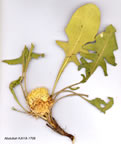| Asteraceae |
 Centaurea sessilis |
 Centaurea sessilis |
| Centaurea L. Centaurea sessilis WILLD. Ömür: Çok yıllık Yapı: ot Hayat formu: İlk çiçeklenme zamanı: 5 Son çiçeklenme zamanı: 7 Habitat: taşlık yamaç Minimum yükseklik: 1650 Maksimum yükseklik: 2450 Endemik: endemik Element: İran-Turan Türkiye dağılımı: D. Anadolu Genel dağılımı: Türkiye Bulunduğu kareler:A7 A8 A9 B7 B8 B9 |
| C. sessilis Willd., Sp. P1. 3(3): 2300 (1803). Syn: C. oltensis Sosn. in Not. Bot. (Tiflis) 21:60 (1959)! Perennial. Capitula single or more often 2-6 close together, sessile or nearly sessile (stem up to 2 cm) in a rosette of leaves. Leaves covered with septate hairs, pinnatipartite or pinnatifid to sublyrate, terminal segment slightly larger, triangular, lateral segments linear-lanceolate, (5-)7-15 pairs, entire or with a single or few coarse teeth. Involucre 17-22(-25) x 10-15(-17) mm, ovoid. Appendages rather large, brown, usually reflexed, short-haired, triangular to lanceolate, with (5-)7-9 cilia on each side (2-3-5 mm) and ending in a spinule of similar length. Flowers yellow, marginal not radiant. Achenes 4-5 mm; pappus 1-2 mm. Fl. 5-7. Stony slopes, 1650-2450 m. Type: Described from Eastern Anatolia ('Armenia'), probably collected by Gundelsheimer (holo. B-Willd. 16605!). E. Anatolia. A7 Gümüşane: Karagöl Da., Sínt. 1894:7161! A8 Erzurum(?): d. Oltu, nr Kop-Kislag, 26 v 1912, Sosnovsky (paratype of C. oltensis)! A(B)8/9 Erzurum: Pasinler to Horasan, nr Aras river, 1650 m, D. 29436! B7 Erzincan: 1 km from Refahiye to Erzincan, Hub.-Mor. 11950! B8 Erzurum: above Erzurum (foot of Tech Da.), vii 1853, Huet! Endemic. Ir.-Tur. element. Related to C. rhizantha, from which it is usually distinct although there are a few intermediate specimens, e.g. A8 Gümüşane: Pazapom nr Bayburt, Boiirgeau! There has been some confusion about this species. Boissier identified it with C. rhizantha, determining at the same time a specimen of the true C. sessilis as C. ustulata DC. Tzvelev in Not. Syst. (Leningrad) 19:440 (1959) mentions a species from N.W. Iran as the true C. sessilis only on the basis of the description, but the type shows the characters as given above and is surely from Turkey. |